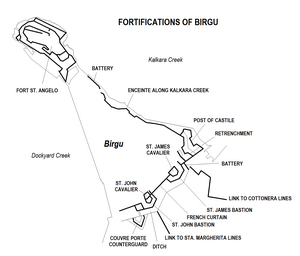Loading AI tools
From Wikipedia, the free encyclopedia
The fortifications of Birgu (Maltese: Is-Swar tal-Birgu) are a series of defensive walls and other fortifications which surround the city of Birgu, Malta. The first fortification to be built was Fort Saint Angelo in the Middle Ages, and the majority of the fortifications were built between the 16th and 18th centuries by the Order of Saint John. Most of the fortifications remain largely intact today.
| Fortifications of Birgu | |
|---|---|
Is-Swar tal-Birgu | |
| Birgu, Malta | |
 St. John Bastion and the Advanced Gate | |
 Map of Birgu's fortifications | |
| Coordinates | 35°53′10″N 14°31′22.8″E |
| Type | City wall |
| Site information | |
| Owner | Government of Malta |
| Condition | Mostly intact |
| Site history | |
| Built | c. 13th century–1691 (Fort St. Angelo) 1530s–18th century (rest of city walls) |
| Built by | Order of Saint John |
| Materials | Limestone |
| Battles/wars | Attack of 1551 Great Siege of Malta (1565) Siege of Malta (1798–1800) |
| Garrison information | |
| Past commanders | Jean de Valette (1565) |
Birgu's fortifications have been on Malta's tentative list of UNESCO World Heritage Sites since 1998, as part of the Knights' Fortifications around the Harbours of Malta.[1] They are also listed as monuments in Birgu as part the National Inventory of the Cultural Property of the Maltese Islands (NICPMI).

The first fortification to be built in Birgu was the Castrum Maris. It is popularly attributed to have been built by the Arabs in around 870, but the earliest references to the castle date back to around the 13th century.[2]
In 1526, the Order of Saint John sent a commission of 8 knights to inspect the island of Malta, which had been offered to them by Emperor Charles V as a potential base following their loss of Rhodes. They described Birgu as a small defenceless town, with its only fortification being the obsolete and partially ruined Castrum Maris.[3]
The Order eventually moved to Malta in 1530 and established itself in Birgu. The first modifications were made to the Castrum Maris, which became Fort Saint Angelo and was used as the Grand Master's residence. Later on, the entire town began to be surrounded by walls, in a similar style to the Order's earlier defences in Rhodes. Birgu's land front was built by 1540.[4]
In 1551, Ottomans attempted to attack Birgu but turned back once they saw the new defences. They attacked again with a much larger force fourteen years later in 1565. The siege, which became known as the Great Siege of Malta, lasted for three months and Birgu was heavily bombarded. After the Great Siege, Birgu's fortifications were repaired, but soon lost most of their importance as the Order moved to its new capital Valletta, and built new fortifications there.
In the 17th and 18th centuries, the Santa Margherita Lines and the Cottonera Lines were built around Birgu's and Senglea's land fronts. These new lines increased the strength of the defensive position, but also reduced the importance of Birgu's land front. Birgu's fortifications were extensively rebuilt in the 18th century, under the direction of the architect Charles François de Mondion.
On 18 July 1806, the gunpowder magazine of Birgu exploded, killing over 200 people.[5]
The fortifications of Birgu were included on the Antiquities List of 1925.[6]
The first plans to restore the fortifications of Birgu were made in 2006, as part of a project that would also involve restoration of the fortifications of Valletta, Mdina and the Cittadella.[7][8] Restoration of Birgu's fortifications began in January 2008, and is currently ongoing.[9]
During the course of restoration work, a bastion that had been built just before the siege of 1565 as well as an 18th-century caponier were discovered.[10] A 20th-century naval oil depot near the Post of Castile was demolished in 2010 to reveal the view of the bastions,[11] and a breach in St. John Bastion was bridged by an arch the following year.[12]
Birgu's ditch was opened to the public as a recreational area in January 2016. The recreational area includes the 18th-century caponier, which was restored and partially reconstructed, as well as the battery at the left extremity of the ditch.[13]

The present layout of Birgu's fortifications is mainly a result of the 18th century rebuilding by the French architect Charles François de Mondion, although the general layout dates back to the mid-16th century. The fortifications consist of (listed going clockwise from Fort St. Angelo to Dockyard Creek):


The entire land front is surrounded by a rock-hewn ditch, which also includes a caponier[24] and another battery.[25] A covertway and glacis were also located close to the land front, but were mostly cleared away in the 19th century.[26]
Birgu had four city gates, three of which still survive. They were designed by Charles François de Mondion in the 18th century, and are in the Baroque style:[27]
Seamless Wikipedia browsing. On steroids.
Every time you click a link to Wikipedia, Wiktionary or Wikiquote in your browser's search results, it will show the modern Wikiwand interface.
Wikiwand extension is a five stars, simple, with minimum permission required to keep your browsing private, safe and transparent.